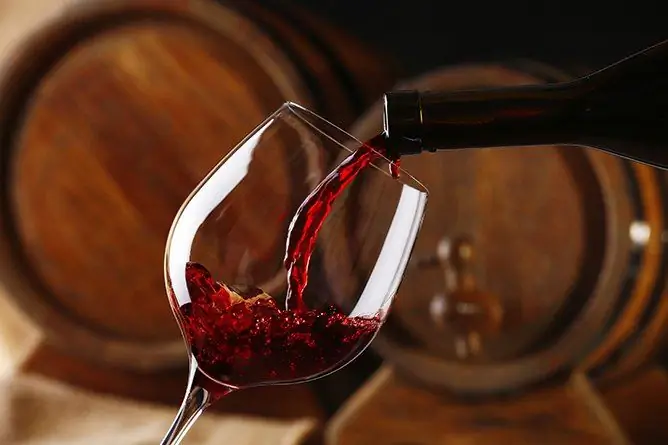- Author Rachel Wainwright [email protected].
- Public 2023-12-15 07:39.
- Last modified 2025-11-02 20:14.
Port wine

Port is a Portuguese traditional liqueur wine. It is made from special grape varieties using a special technology. The grapes for this drink are grown in the upper reaches of the Douro River, in the northeastern part of Portugal.
This alcoholic beverage can be aged for forty to fifty years, but most often it is consumed within three years after production. Establishes the classification of wine and controls its production by the Portuguese Institute of Wine.
Port wine making technology
The Portuguese technology for making port wine provides for grinding (crushing) grapes, separating ridges, fermenting grape pulp, separating the must from the pulp, and fortifying the must. The degree of extraction of extractable compounds from it depends on how carefully the grapes are crushed. About 1% of the drink is made according to the Romanesque technology, used in antiquity (crushing berries with your feet). Most of the port varieties are produced using blended wines of different years. The unfermented sugar determines the sweetness of the drink.
Port wine classification
The first year harvest port is referred to as the vintage port. Currently, the vintage port is considered one of the rarest port wines. Ripening of non-vintage ports can take from three to forty years.
Port wine is subdivided into red, white and golden colors. Each bottle of the drink must bear the sign of the National Port Institute. White ports are produced dry, extra dry, semi-dry and semi-sweet. The white drink has a golden, light straw and dark golden color, red - ruby, red, dark red and brick.
Nowadays, in our country, a fairly wide range of both ordinary and vintage wines such as port is produced.
Useful properties of port
The beneficial properties of port for the human body are explained by its chemical composition, natural origin and dietary properties. This drink is able to restore the vitality of the body, increase vigor. It helps to cleanse the whole body as a whole, and also reduces the risk of vascular atherosclerosis. Trioxystilbene is a unique component of the drink that slows down the aging process of cells. Since port wine has pronounced antibacterial properties, it is very useful to consume this drink in small quantities for colds and chronic diseases. The antibacterial effect of port is preserved even when the drink is diluted with water. Regular consumption of the drink in small quantities helps with obesity, with metabolic disorders in the body. Port wine is also useful for radiation exposure.

Drinking port wine in large doses can cause significant harm to the human body, and in small doses, the drink speeds up the healing process in various diseases. A negative effect is also observed when mixing port with other drinks - beer, vodka, etc.
Ways to consume port
Port should be drunk chilled. Inexpensive red port is most often used as a dessert. It serves as a good base for many cocktails. White port goes well with orange, lemon juice. Vintage ports are drunk chilled and used as an aperitif.
Port wine like Madeira, sherry goes well with smoked meats, ham, pickled and salted vegetables, and salmon. When preparing cocktails, this drink goes well with liqueurs, beer, cognac, fruit juices and some dessert wines.
In Portugal, they developed a special glass for drinking this drink - a glass colorless spherical container with a thin leg, tapering slightly at the top. Glass capacity - 140-250 ml. It should be filled no more than half.
According to experts, this drink is best combined with various nuts or soft cheese. It is believed that red port wines are best suited to red meat, and white - to white.
Port is stored in bottles laid horizontally.
Found a mistake in the text? Select it and press Ctrl + Enter.






